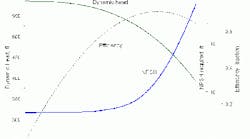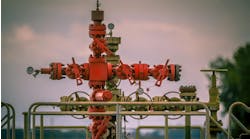Centrifugal pumps impart velocity to a fluid and then recover the velocity as pressure head. Performance curves depict the total dynamic head generated at a given flow rate for a specific impeller and rotational speed (Figure 1). They typically show total dynamic head in feet, not psi, unless the curves are for a defined liquid.
[pullquote]You can convert pressure rise from feet to psi via:
ΔP = ρΔH/144 (1)
where ΔP is pressure rise in psi, ρ is density in lb/ft3, and ΔH is dynamic head in feet.
Pump work applied to the fluid is:
W = QΔP/1,714η (2)
where W is work in hp, Q is flow in gpm, and η is pump efficiency, as a fraction of one.
Both ΔP and W vary with liquid density. So, you must know the density to convert from a dynamic pump performance curve to the physical pressure rise or power required.
Pump efficiency varies with flow rate. In addition, the efficiencies of the drive system (belts, gears, couplings, etc.) and driver come into play. For an electrically driven pump, the driver efficiency is the motor efficiency. This can vary as a function of total load. Motor efficiencies drop at low loads.
Dynamic head in feet doesn't change as density changes. Imposed pressure in psi and power demand will vary as liquid density varies. For many processes and conditions, the density is well understood and known in advance.
However, densities can vary dramatically in some common situations. For instance, at startup many units are cold, so densities are higher, increasing power demands. Let's look at a situation where startup density differences created motor problems.
Figure 2 shows the bottoms of a high temperature distillation tower. The startup procedure required circulating cold tower bottoms to the fired heater reboiler. Limits on both the pump (suction specific speed) and the fired heater (minimum safe firing with air control) restricted flow rate to 1,500 gpm for starting conditions. The design operation was 2,250 gpm. Obviously, the pump can handle the lower flow rate.
However, startup usually was a hit-or-miss affair because the pump motor's thermal protection system was near its trip point, a power draw equivalent to 300 hp. Table 1 illustrates the normal and startup conditions; efficiency takes into account the pump, driver and coupling, as well as an allowance for efficiency changes due to high viscosity at the startup condition. Designers should have factored in the need for some extra startup power.
Good practice requires thinking about different operating points. Consider, for instance, startup at cold conditions, higher viscosity operation, pumping heavier fluids, and installing larger diameter impellers in the future.
Many companies, as standard practice, buy pumps with some room to increase impeller size later to boost capacity. Greater throughput plus higher discharge head from a larger impeller rapidly raises the pump power required. Prudent engineering practice is to select a motor sized for the maximum impeller that fits in the casing.
In the end, economics sets the best motor sizing choice. Higher investment now for a larger motor saves money in both the motor, electrical systems and, perhaps, foundation later. It also enhances pump reliability. Power consumption costs really don't change a lot with larger motors.
Of course, this logic only goes so far. Multiple margins for cold startup conditions with larger impellers may lead to drastic oversizing. Motors that run at small fractions of their design load have lower efficiency.
Use engineering judgment to choose the right motor size. Large motors with significant capital costs may require a true lifecycle analysis of total system cost.
ANDREW SLOLEY is Chemical Processing Contributing Editor. You can e-mail him at [email protected]





